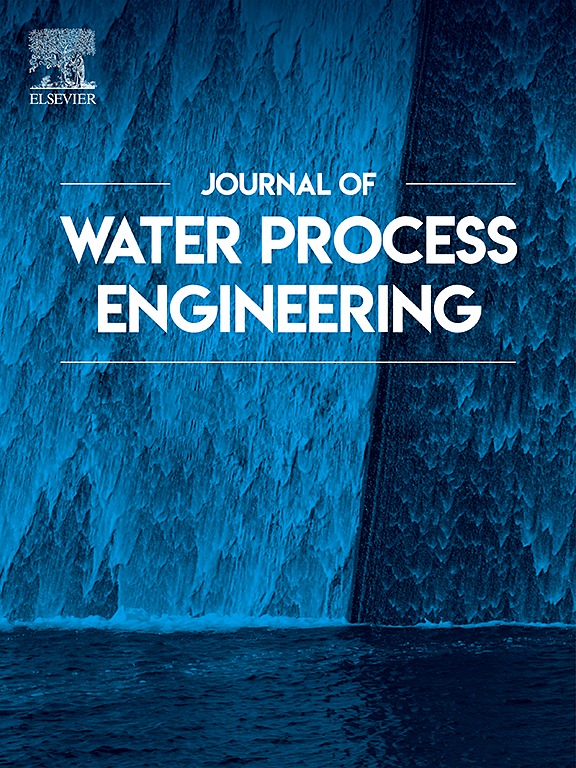Enhancing Anammox-sulfur autotrophic denitrification coupling with sludge/coal gangue biochar: Nitrogen removal performance and microbial community dynamics
IF 6.3
2区 工程技术
Q1 ENGINEERING, CHEMICAL
引用次数: 0
Abstract
Sulfur autotrophic denitrification (SADN) can reduce nitrate produced by anaerobic ammonium oxidation (Anammox) to nitrite, providing an electron acceptor for Anammox. This study investigated the effects of sludge/coal gangue-based biochar (SCBC) on the coupled process of Anammox and SADN. The results indicated a significant rise in NH4+-N removal efficiency (ANRE) from 42.4 % to 75.0 %, and total nitrogen removal efficiency from 83.2 % to 91.7 % upon introducing SCBC. Furthermore, SCBC elevated extracellular polymeric substances content from 10.3 ± 0.5 to 14.1 ± 0.7 mg·gSS−1 and the protein/polysaccharide ratio from 3.3 to 4.4, bolstering system stability. SCBC reduced Thiobacillus abundances from 48.0 % to 45.0 %, while respectively increasing Sulfurimonas and Candidatus Brocadia abundances from 3.2 % to 3.3 % and 0.2 % to 3.9 %, which suggested an enrichment of anaerobic ammonia-oxidizing bacteria. In conclusion, SCBC addition improves Anammox-SADN coupling, opening new avenues for nitrite supply in Anammox and nitrate treatment. It also presents a novel approach for sludge and coal gangue utilization.
污泥/煤矸石生物炭强化厌氧氨氧化-硫自养反硝化耦合:脱氮性能和微生物群落动态
硫自养反硝化(SADN)可以将厌氧氨氧化(Anammox)产生的硝酸盐还原为亚硝酸盐,为Anammox提供电子受体。研究了污泥/煤矸石基生物炭(SCBC)对厌氧氨氧化与SADN耦合过程的影响。结果表明,引入SCBC后,NH4+-N去除率(ANRE)从42.4%提高到75.0%,总氮去除率从83.2%提高到91.7%。此外,SCBC将细胞外聚合物含量从10.3±0.5 mg·gSS−1提高到14.1±0.7 mg·gSS−1,蛋白质/多糖比从3.3提高到4.4,增强了系统的稳定性。SCBC将硫杆菌丰度从48.0%降低到45.0%,硫单胞菌和布罗Candidatus Brocadia丰度分别从3.2%和0.2%提高到3.3%和3.9%,表明厌氧氨氧化细菌富集。综上所述,SCBC的加入改善了厌氧氨氧化- sadn的耦合,为厌氧氨氧化和硝酸盐处理中亚硝酸盐的供应开辟了新的途径。为污泥和煤矸石的资源化利用提供了一条新的途径。
本文章由计算机程序翻译,如有差异,请以英文原文为准。
求助全文
约1分钟内获得全文
求助全文
来源期刊

Journal of water process engineering
Biochemistry, Genetics and Molecular Biology-Biotechnology
CiteScore
10.70
自引率
8.60%
发文量
846
审稿时长
24 days
期刊介绍:
The Journal of Water Process Engineering aims to publish refereed, high-quality research papers with significant novelty and impact in all areas of the engineering of water and wastewater processing . Papers on advanced and novel treatment processes and technologies are particularly welcome. The Journal considers papers in areas such as nanotechnology and biotechnology applications in water, novel oxidation and separation processes, membrane processes (except those for desalination) , catalytic processes for the removal of water contaminants, sustainable processes, water reuse and recycling, water use and wastewater minimization, integrated/hybrid technology, process modeling of water treatment and novel treatment processes. Submissions on the subject of adsorbents, including standard measurements of adsorption kinetics and equilibrium will only be considered if there is a genuine case for novelty and contribution, for example highly novel, sustainable adsorbents and their use: papers on activated carbon-type materials derived from natural matter, or surfactant-modified clays and related minerals, would not fulfil this criterion. The Journal particularly welcomes contributions involving environmentally, economically and socially sustainable technology for water treatment, including those which are energy-efficient, with minimal or no chemical consumption, and capable of water recycling and reuse that minimizes the direct disposal of wastewater to the aquatic environment. Papers that describe novel ideas for solving issues related to water quality and availability are also welcome, as are those that show the transfer of techniques from other disciplines. The Journal will consider papers dealing with processes for various water matrices including drinking water (except desalination), domestic, urban and industrial wastewaters, in addition to their residues. It is expected that the journal will be of particular relevance to chemical and process engineers working in the field. The Journal welcomes Full Text papers, Short Communications, State-of-the-Art Reviews and Letters to Editors and Case Studies
 求助内容:
求助内容: 应助结果提醒方式:
应助结果提醒方式:


